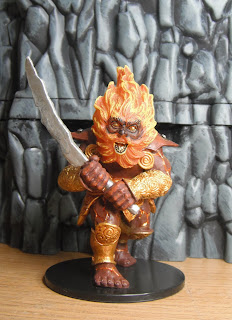I'm not too familiar with the Pathfinder system from Paizo Publishing, and I haven't purchased any of their books so I don't have an opinion regarding their products, but recently I've taken quite an interest in their line of miniatures.
Paizo has started filling the void created a couple of years back following the demise of the D&D CMG line with their Pathfinder miniatures. From what I can tell, the miniatures are faithfully modeled after the images used in their artwork.
The vast majority are probably too big for 1/72 scale gaming, but as usual, there are always candidates that can be adopted for use.
Many of the giant class monsters from the Pathfinder line are similar in size and build to the D&D CMG giants that I use for gaming. Below, from left to right, are the Troll Champion (Shattered Star 036), Fire Giant (Shattered Star 032), and Hill Giant (Shattered Star 031).
I don't mind my fantasy miniatures being flamboyant, but the spikes on the Fire Giant were too much for me. I chopped them off, and added some pinheads as more subtle decoration. The tusks and tongue of the Troll Champion are a bit OTT as well, but I think I can live with those.
Some of the giant class creatures are less massive than the others. These miniatures have less stylized proportions, so they have a very different look (at least in my eyes) from the other giants.
The Stone Giant (Rise of the Runelords 39), and Cyclops (Skulls & Shackles 034) are a lot less imposing than their bulkier compatriots. The pose of the Stone Giant doesn't help, since it make it seem shorter than it actually is, and I'm not too crazy about the moai-like head either.
At the other end of the spectrum are the small sized miniatures. Some of them are absolutely tiny compared to 28mm figures, but they look pretty good next to 1/72 figures.
From left to right, we have two Derro – Caedimus (Shattered Star 01) and Portioque (Shattered Star 02), a
Redcap (Rise of the Runelords 12), and a typical Pathfinder Goblin Warrior (We Be Goblins 01). The Derro are weedy fellows compared to the typical dwarf, but I like them. For some reason, they are how I imagine the Nibelungs from Wagner's Das Rheingold would look. The Pathfinder goblin looks really big because of its over-sized head, but I think that a headswap would make it quite suitable for use as a 1/72 orc.
Next, we have miniatures that would be roughly human sized in 1/72 scale. Consistent with the D&D miniatures in the past, Pathfinder gnomes and halflings can easily pass as humans.
From left to right are a Gnome Fighter (Heroes & Monsters 22), Rosie Cuswell (Skulls & Shackles 038), and a Harpy (Rise of the Runelords 08). The gnome is on the short side, but he still looks in scale. I had to fix the halfling up a bit, because the paint was layered on really thick, leaving various lumpy areas all over her arms. I think that she's holding a violin bow in her right hand, but it's the size (and shape) of a cleaver. Again, the harpy is a Pathfinder miniature that would look small next to a 28mm figure, but fits in almost perfectly with 1/72 scale figures.
One of the more iconic monsters from the Fiend Folio that finally makes its appearance in miniature form is the Caryatid Column (Shattered Star 020). This is the figure that really got me to look into the line of Pathfinder miniatures. They are modeled after actual caryatid columns (although armed with swords), and can be used as architectural details or monsters.
Last up are some monsters unique to the Pathfinder RPG. I picked these figures up without knowing anything about them just because they looked cool. The tall model on the left is a Clockwork Reliquary (Shattered Star 049), while the rotund model on the right is a Forgefiend (Rise of the Runelords 57)
Maybe it's just me, but I found the two round things on top of the Clockwork Reliquary to be a rather unfortunate design choice. The skeleton in the Reliquary is also obviously too large even for 28mm figures (though I guess it could be the skeleton of a giant). To remedy the situation, I decided to take the miniature apart.
I found some plastic Mega Bloks flames, which I will place on top of the model (I'm undecided as to whether to use the large flame or the small one). I wanted to open up the crystal and replace the skeleton inside, but I think it would be very difficult to do so without damaging the clear plastic. I'll probably use the Dark Art to replicate the crystal, and cast a replacement with a skeleton embedded inside.
The Forgefiend is another model that is crying out for enhancement. I am going to install an LED as described at SeanKReynolds.com, though I'll probably run the wires through its legs and out the bottom of its feet. I've already used acetone to remove the paint from the Forgefiend's mouth and eyes, so that they will glow when it is lit up.
Anyway, my overall impression is that the Pathfinder miniatures are a worthy successor to the D&D CMG line. There have been some people complaining that the figures are not as durable as the D&D miniatures, but I have not found that particular problem. The larger models do seem to have some parts made of a harder plastic, so they may be more fragile, but I haven't really had anything come apart unless I was trying to do it on purpose.
Women Warriors 351
20 hours ago






























No comments:
Post a Comment